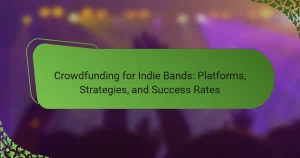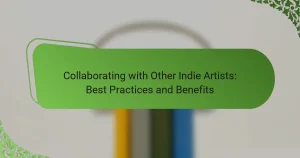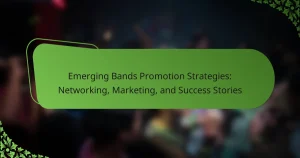Emerging artists face challenges in understanding music licensing, which is crucial for protecting their work and maximising revenue. This article explores essential licensing rights, including reproduction, distribution, performance, and synchronization rights. It also highlights strategies for navigating the licensing process, accessing opportunities like sync licensing and digital distribution, and the importance of networking with industry professionals. Staying informed about copyright laws and utilising available resources can enhance artists’ success in the music industry.
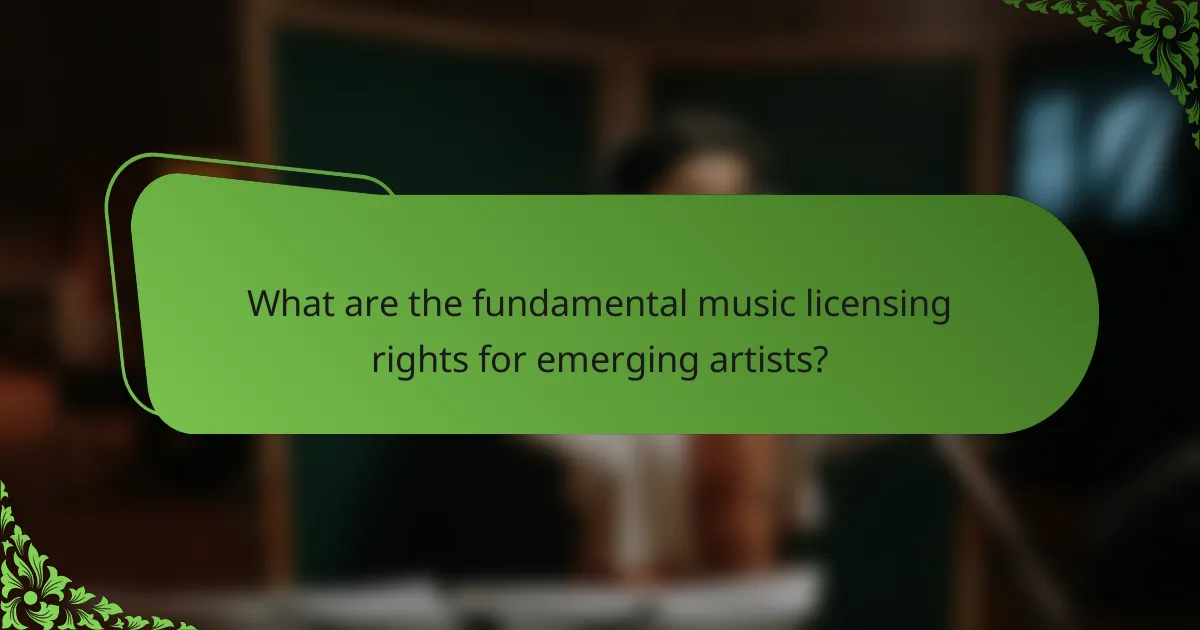
What are the fundamental music licensing rights for emerging artists?
Emerging artists must understand four fundamental music licensing rights: reproduction rights, distribution rights, performance rights, and synchronization rights. These rights govern how music can be used, ensuring artists receive compensation.
Reproduction rights allow artists to control the copying of their work, while distribution rights pertain to the sale and distribution of that work. Performance rights grant artists the ability to earn from public performances, and synchronization rights cover the use of music in audiovisual projects.
Understanding these rights enables emerging artists to protect their creations and maximise revenue opportunities.
How do copyright laws affect music licensing?
Copyright laws significantly influence music licensing by defining the rights of creators and the usage of their work. Emerging artists must understand these laws to navigate opportunities for fair compensation and exposure. Copyright grants artists exclusive rights to their music, allowing them to license it for various uses, such as streaming, broadcasting, and synchronization with visual media.
For instance, the duration of copyright protection typically lasts for the life of the artist plus 70 years, influencing how long they can control their work. Unique attributes like the ability to negotiate licensing agreements can empower artists, while rare attributes, such as collective rights management, may offer additional avenues for revenue. Proper knowledge of copyright laws helps emerging artists maximise their potential in the music industry.
What are the different types of licenses available for new musicians?
New musicians can explore several types of licenses to protect their work and maximise opportunities. Key licenses include mechanical licenses for reproducing music, synchronization licenses for pairing music with visual media, performance licenses for public performances, and master use licenses for using a specific recording. Each license serves distinct purposes, enabling artists to monetise their creative output effectively.
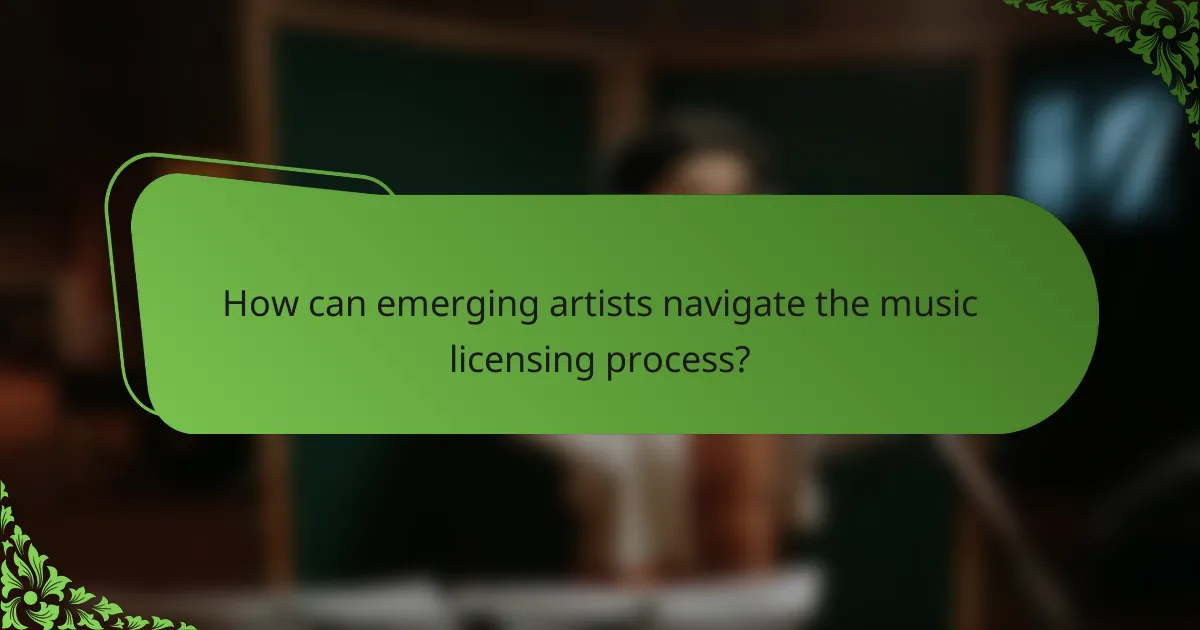
How can emerging artists navigate the music licensing process?
Emerging artists can navigate the music licensing process by understanding their rights and exploring available opportunities. They should start by identifying the types of licenses needed, such as mechanical, synchronization, and performance licenses. Researching licensing organizations and using online platforms can simplify the process. Additionally, networking with industry professionals can provide valuable insights and support. Staying informed about copyright laws is essential for protecting their work. Finally, utilising resources like workshops and online courses can enhance their knowledge and skills in music licensing.
What steps should artists take to secure their music rights?
Artists should register their works, understand licensing agreements, and seek legal advice. Securing music rights involves several essential steps to protect creative output.
1. Register works with a performing rights organization (PRO) to ensure royalties.
2. Understand the types of licenses available, including mechanical and synchronization licenses.
3. Use clear contracts when collaborating with producers or other artists to define rights.
4. Consider joining a music rights organization for additional support and resources.
5. Consult with a legal expert specializing in music law to navigate complex rights issues.
Which organizations can assist with music licensing?
Organizations that assist with music licensing include performing rights organizations, music publishers, and licensing agencies. These entities help emerging artists navigate their rights and opportunities in music licensing. Notable organizations include ASCAP, BMI, and SESAC, which manage performance rights. Music publishers like Universal Music Publishing Group offer support in securing licenses. Licensing agencies such as Songtrust provide comprehensive services for managing royalties and licensing deals. These organizations play a crucial role in ensuring artists receive fair compensation for their work.
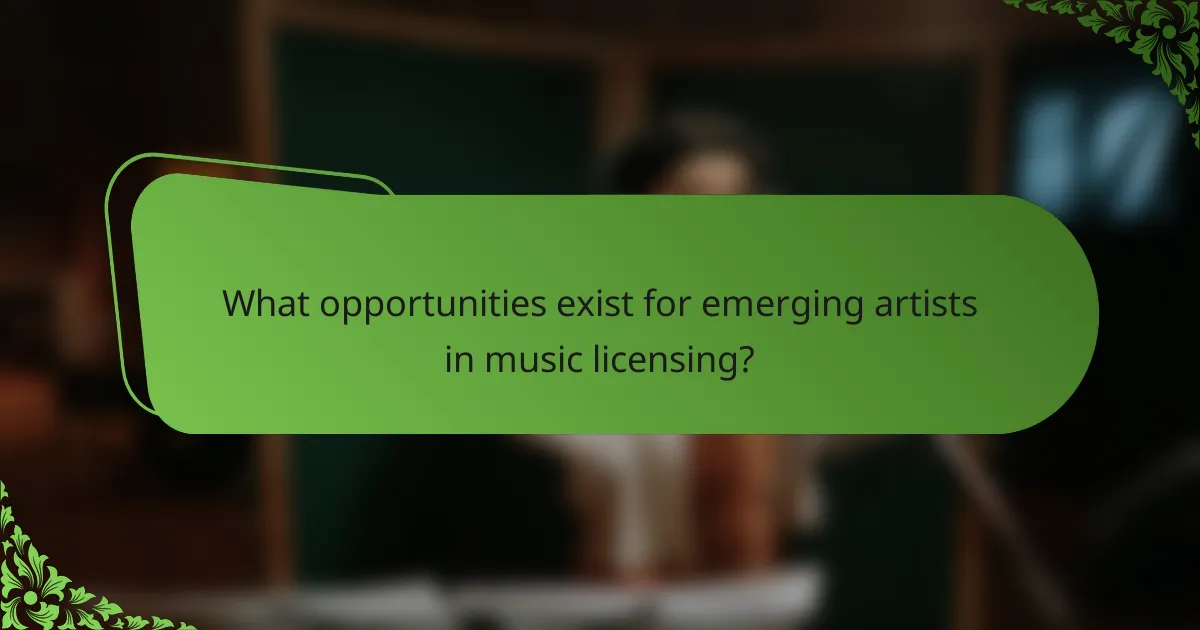
What opportunities exist for emerging artists in music licensing?
Emerging artists in music licensing can access various opportunities, including sync licensing, performance rights, and digital distribution. Sync licensing allows artists to place music in films, commercials, and video games, providing exposure and revenue. Performance rights enable artists to earn royalties when their music is played in public venues. Digital distribution platforms facilitate global reach, allowing artists to monetise their work through streaming services. These avenues not only enhance visibility but also contribute to sustainable income streams for emerging musicians.
How can sync licensing enhance an artist’s exposure?
Sync licensing can significantly enhance an artist’s exposure by placing their music in various media, such as films and commercials. This exposure can lead to increased recognition and a broader audience. By aligning their music with visual content, artists create memorable associations that attract new fans. Furthermore, sync licensing offers financial benefits through royalties, enabling artists to invest in their careers. As a result, emerging artists can leverage these opportunities to build their brand and expand their reach in the competitive music industry.
What platforms are best for licensing music in 2025?
In 2025, platforms like DistroKid, TuneCore, and Epidemic Sound are best for licensing music. These platforms provide emerging artists with opportunities to monetise their work while maintaining rights. DistroKid offers fast distribution and a user-friendly interface, while TuneCore allows for comprehensive rights management. Epidemic Sound focuses on sync licensing, ideal for artists seeking placement in media. Each platform has unique attributes that cater to specific needs, ensuring artists can effectively navigate the music licensing landscape.
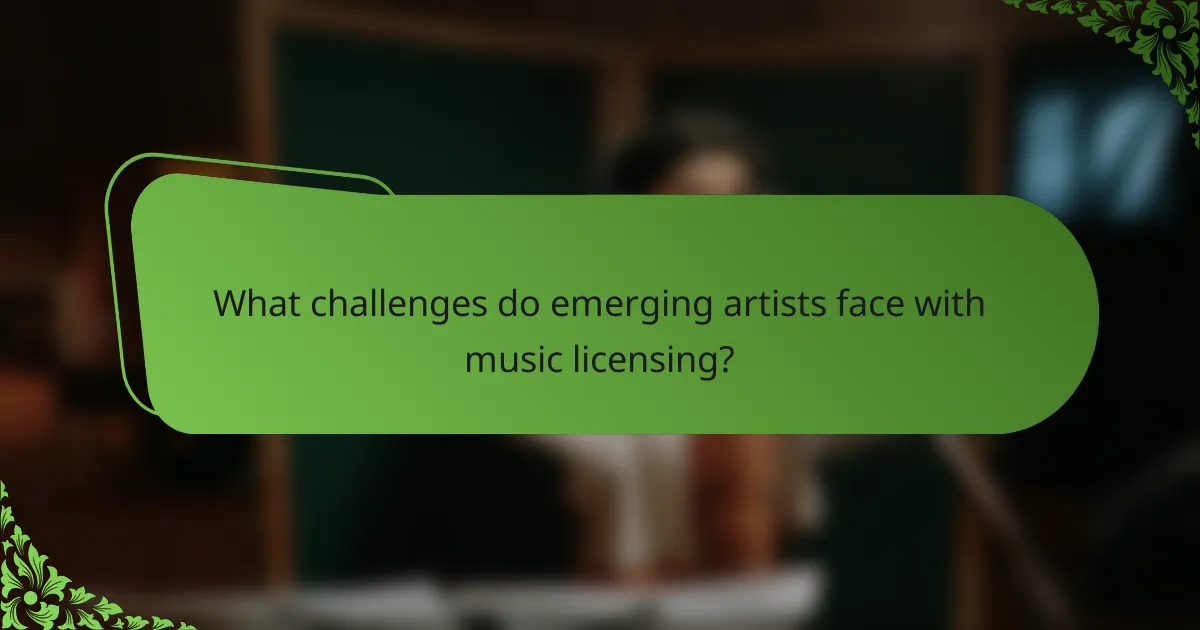
What challenges do emerging artists face with music licensing?
Emerging artists face significant challenges with music licensing, including complexity, cost, and limited access to resources. Navigating licensing agreements can be confusing due to varying rights and regulations. Additionally, many emerging artists lack the financial means to secure proper licenses, which can hinder their ability to distribute music legally. They often encounter difficulties in understanding the differences between mechanical, synchronization, and performance licenses. As a result, this knowledge gap can lead to unintentional copyright infringements, impacting their careers.
How do financial constraints impact licensing opportunities?
Financial constraints significantly limit licensing opportunities for emerging artists. Limited budgets restrict access to quality production, marketing, and legal advice, hindering their ability to secure lucrative licensing deals. Additionally, financial barriers may prevent artists from participating in essential networking events, reducing their visibility in the industry. As a result, many emerging artists struggle to navigate the complex landscape of music licensing effectively.
What common mistakes do new artists make in licensing their music?
New artists often make mistakes in music licensing by overlooking essential rights and opportunities. Common errors include failing to understand copyright ownership, neglecting to register their works, underestimating the importance of contracts, and not exploring various licensing avenues. These missteps can limit their revenue potential and creative control. Additionally, many artists mistakenly assume all licenses are the same, leading to unfavorable terms. Understanding these pitfalls can empower emerging artists to navigate the licensing landscape effectively.
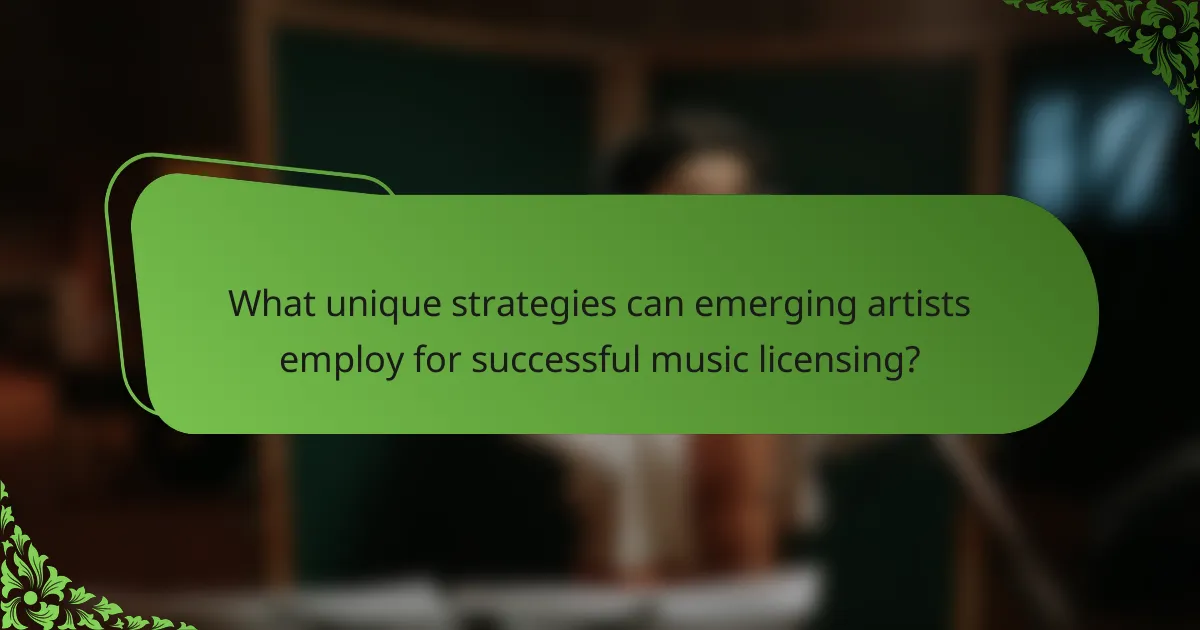
What unique strategies can emerging artists employ for successful music licensing?
Emerging artists can utilise unique strategies such as networking, leveraging digital platforms, and creating targeted music for specific media needs. Networking with industry professionals can lead to valuable connections and opportunities. Digital platforms like music libraries and licensing websites allow artists to showcase their work widely. Additionally, understanding specific media requirements can help tailor compositions to fit licensing opportunities.
How can collaborations influence licensing opportunities?
Collaborations enhance licensing opportunities for emerging artists by expanding their reach and network. By partnering with established artists or brands, they gain access to new audiences and increased visibility. Collaborations can lead to unique content that attracts licensing deals, as originality is a key factor in the music industry. Additionally, shared resources and expertise can improve the quality of their work, making it more appealing to potential licensors.
What role does digital distribution play in licensing for new artists?
Digital distribution plays a crucial role in licensing for new artists by providing access to a broader audience. It allows emerging musicians to distribute their music globally, increasing visibility and potential revenue sources. With platforms like Spotify and Apple Music, artists can license their work more efficiently and reach fans directly. This democratization of music distribution empowers artists to negotiate better licensing deals and retain more rights over their work. Moreover, digital distribution facilitates data collection on listener preferences, which can inform future licensing strategies and marketing efforts.
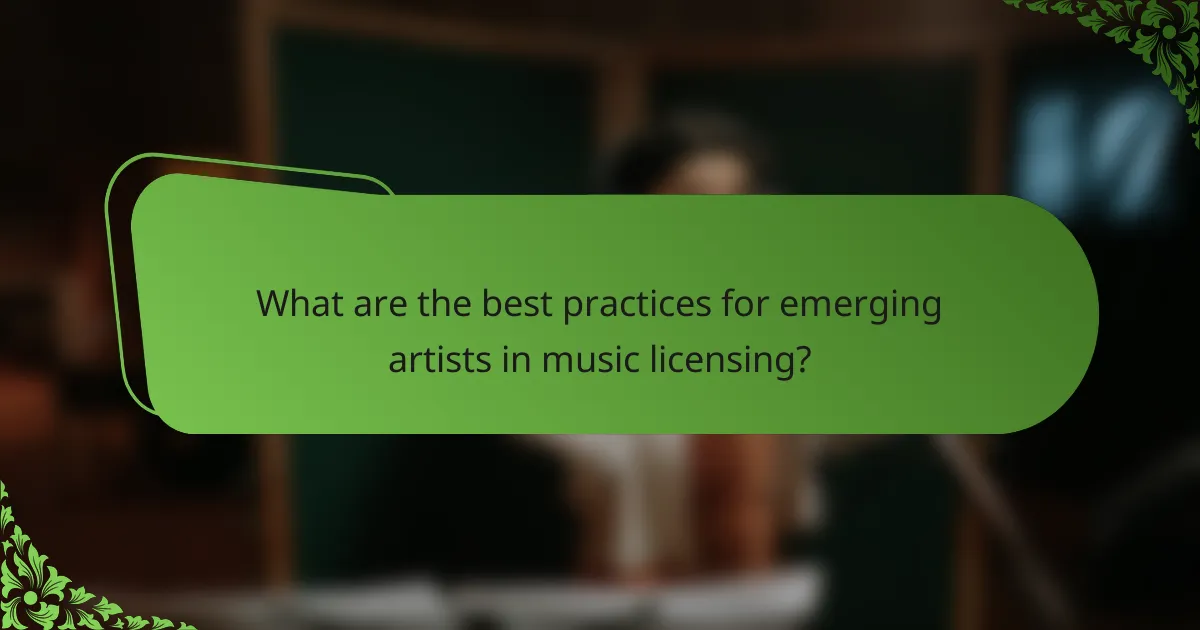
What are the best practices for emerging artists in music licensing?
Emerging artists should prioritise understanding their rights, exploring diverse licensing opportunities, and networking with industry professionals. Knowledge of copyright laws is essential for protecting their work. Collaborating with music supervisors can open doors to placements in film and television, enhancing exposure. Additionally, utilising platforms that facilitate licensing can streamline the process and expand reach. Engaging in social media can build a fan base that attracts potential licensing deals.
How can artists effectively promote their licensed music?
Artists can effectively promote their licensed music by leveraging social media, collaborating with influencers, and utilising music distribution platforms. These strategies enhance visibility and audience engagement.
Social media platforms like Instagram and TikTok allow artists to share snippets of their music, connect with fans, and create viral trends. Collaborating with influencers can introduce music to new audiences. Additionally, using music distribution services ensures that licensed tracks reach streaming platforms, maximising exposure.
Engaging with music blogs and online communities can further amplify reach. Building a strong online presence and networking within the industry are essential for emerging artists to navigate music licensing successfully.
What resources are available for ongoing education about music licensing?
Emerging artists can access various resources for ongoing education about music licensing, including online courses, webinars, and industry workshops. These resources help artists understand their rights and opportunities in the music industry. Websites like Coursera and LinkedIn Learning offer courses on music rights, while organizations like the American Society of Composers, Authors and Publishers (ASCAP) provide webinars and events. Additionally, music licensing books and podcasts serve as valuable tools for continuous learning. Networking with industry professionals through social media platforms can also enhance knowledge and awareness of current trends and regulations.
